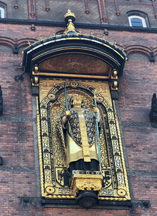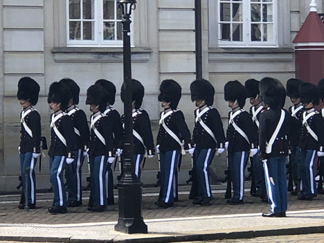Charismatic Copenhagen
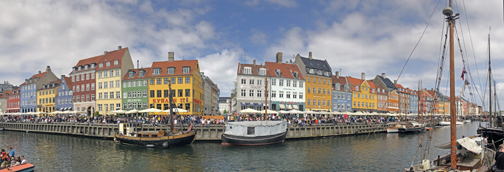 I think it was very close to 50 years ago when I last visited Copenhagen—the then usual between-high-school-and-college two-month tour of Europe: twelve countries; rail pass; youth hostels or sleeping on trains or in the park; cheap eats and beer. All that really comes to mind of the city are Tivoli Gardens and Georg Jensen silver.
I think it was very close to 50 years ago when I last visited Copenhagen—the then usual between-high-school-and-college two-month tour of Europe: twelve countries; rail pass; youth hostels or sleeping on trains or in the park; cheap eats and beer. All that really comes to mind of the city are Tivoli Gardens and Georg Jensen silver.
Like Oslo, Stockholm, San Francisco, Vancouver, or Hong Kong, being a harbor city is a defining characteristic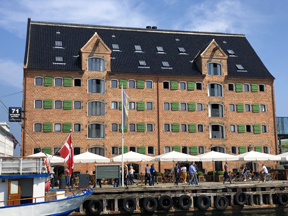 of Copenhagen: bays, inlets, channels, canals—water everywhere. Our hotel, 71Nyhaven, has great advantage in that regard, as it sits dockside at the edge of the channel, or havn, off Øresund that divides Copenhagen into two islands. Originally a trading warehouse built in 1805, it was converted to a hotel in 1971, and recently completely renovated. Huge rough raw beams, white plaster walls and sliding wooden Z shutters combine with Danish modern furniture in a charming fusion. Our corner junior suite, 201, while not huge, is cozy and light filled, facing the harbor and all its activity. Dark beams continue into the gleaming white and glass bathroom, compact and ship-like, with a very good shower. If you book, best bet is to ask for an 02 corner suite—just a bit larger, and slightly better canal view.
of Copenhagen: bays, inlets, channels, canals—water everywhere. Our hotel, 71Nyhaven, has great advantage in that regard, as it sits dockside at the edge of the channel, or havn, off Øresund that divides Copenhagen into two islands. Originally a trading warehouse built in 1805, it was converted to a hotel in 1971, and recently completely renovated. Huge rough raw beams, white plaster walls and sliding wooden Z shutters combine with Danish modern furniture in a charming fusion. Our corner junior suite, 201, while not huge, is cozy and light filled, facing the harbor and all its activity. Dark beams continue into the gleaming white and glass bathroom, compact and ship-like, with a very good shower. If you book, best bet is to ask for an 02 corner suite—just a bit larger, and slightly better canal view.
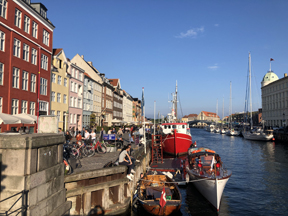 Nyhavn is the oft photo-featured three block-long district along a sailboat-lined canal (where trade from all over the world once unloaded) cluttered with cafes and restaurants fronting a riot of colorful 3-4 story former warehouses in yellow, ochre, pink, rust, cornflower and more. Legend has it that there were originally no addresses, and a building’s color indicated it’s use: bar, brothel, café, rooming house. It’s really a bright and lovely area, teeming with locals and tourists—very reminiscent of Alesund, where we began our northward Norwegian ferry odyssey a couple of years ago.
Nyhavn is the oft photo-featured three block-long district along a sailboat-lined canal (where trade from all over the world once unloaded) cluttered with cafes and restaurants fronting a riot of colorful 3-4 story former warehouses in yellow, ochre, pink, rust, cornflower and more. Legend has it that there were originally no addresses, and a building’s color indicated it’s use: bar, brothel, café, rooming house. It’s really a bright and lovely area, teeming with locals and tourists—very reminiscent of Alesund, where we began our northward Norwegian ferry odyssey a couple of years ago.
King Christian IV founded the Nyhavn district in order to handle the growing trade that Copenhagen experienced in the 1600s. The trading harbor was completed in 1673 and was named “Gyldenløves Kanal”, but the residents of Copenhagen called it Nyhavn—new harbor—and over time that became the official name.
The hotel features art from the owner’s private collection of the European avant-garde movement CoBrA from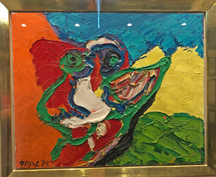 Paris—highly abstract and primitive work that was strongly inspired by the art of children and, it is said, the mentally ill. It’s very bold and colorful work—some of it to our taste, some not quite so much.
Paris—highly abstract and primitive work that was strongly inspired by the art of children and, it is said, the mentally ill. It’s very bold and colorful work—some of it to our taste, some not quite so much.
The young hotel staff are all very friendly, welcoming and helpful—eager to impart information about the city to enhance our visit. The lobby, lounge bar and restaurant all feature the same stylistic combination of dark wood beams, black iron fittings, white walls, and iconic Danish furniture. The restaurant is called sea by Kiin Kiin—part of a restaurant group whose flagship Kiin Kiin has a Michelin star. It is Thaï influenced 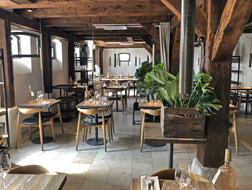 Nordic cuisine and very creative. The cocktail list features gin, and runs to 30 or so varieties. We try a Copenhagen London Dry gin and tonic, and a house Osaka martini with sake in lieu of vermouth, garnished with a bit of cured plum.
Nordic cuisine and very creative. The cocktail list features gin, and runs to 30 or so varieties. We try a Copenhagen London Dry gin and tonic, and a house Osaka martini with sake in lieu of vermouth, garnished with a bit of cured plum.
We start the meal with watercress & cucumber salad with tiger prawns flavored with an incredible Thai marinade, and then move on to several other very memorable courses.
Saturday morning opens gray, but by mid-day the sun is out and so are the Danes. A twenty-minute wander through the lanes brings us to Nikolaj Plads and Segway Tours Copenhagen for a new and exciting adventure. After 15 minutes of instruction in perching on two footpads set between a couple of 16 inch rubber wheels, with a T handle sticking up out of it, we set out like ducklings in line behind momma, following our young Dutch guide Mark down bike lanes, through dense cycle and pedestrian traffic, and across busy streets for a two hour, eight kilometer tour of the city. We glide window shopping along Strøget, the main shopping and fashion street (six-inch Christian Louboutins, anyone?), through the star-shaped Kastellet fortress, past the 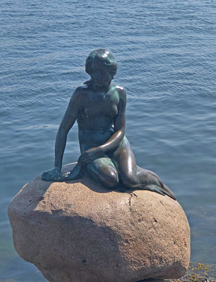 famous Little Mermaid statue at the harbor’s edge and the modern canal-side opera house and stop for a visit of the striking green-domed Frederik’s Kirke and Amalianbourg Palace, where flags indicate that Crown Prince Frederik is in residence, but that Queen Margarethe is not. The tour motors down the quai-side, through the dense throngs along Nyhavn, and we have to hold in place while the drawbridge over the canal lowers—staying still on these beasts takes a bit of practice. But this is fun!...and a great way to do an initial tour covering a lot of grounds. We’ll no doubt want to do it in other places. We exchange our machines for a cold draft Carlsberg with a bit of regret—can we rent
famous Little Mermaid statue at the harbor’s edge and the modern canal-side opera house and stop for a visit of the striking green-domed Frederik’s Kirke and Amalianbourg Palace, where flags indicate that Crown Prince Frederik is in residence, but that Queen Margarethe is not. The tour motors down the quai-side, through the dense throngs along Nyhavn, and we have to hold in place while the drawbridge over the canal lowers—staying still on these beasts takes a bit of practice. But this is fun!...and a great way to do an initial tour covering a lot of grounds. We’ll no doubt want to do it in other places. We exchange our machines for a cold draft Carlsberg with a bit of regret—can we rent 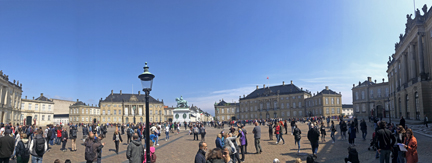 these to motor around town on our own. Sorry!
these to motor around town on our own. Sorry!
For dinner that evening we enter the cool gray facade of Iluka, a hot new seafood restaurant led by Australian-born and noma veteran Chef Beau Clugston. The minimalist interiors look into an enclosed garden, and the menu is equally minimalist. Iluka’s motto is “whatever the sea brings us” and that includes oysters, shellfish and various fish. There is a five-course tasting menu, but we create our own.
After a lovely dinner we stroll several blocks to the central square Kongens Nytorv, and pop in for a quick inspection of the Hotel d’ Angleterre, probably the top hotel in town. After the site visit, we settle in for a post-prandial Manhattan at the elegant curved granite bar, a fitting close to 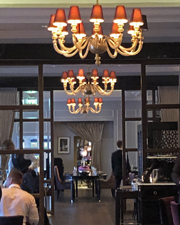 a great day of exploration.
a great day of exploration.
In sea restaurant, the daily breakfast buffet—morgenmad—is included in the room rate, and offers a plethora of foods to fit anyone’s taste: smoked salmon, herring, smoked and cured meats, pate, cheeses.....multiple Scandinavian rye, sour and grain breads, pastries, muffins, crispbreads.......yoghurt, muesli, granola, dried and fresh fruits, health smoothies, and at the open kitchen counter, sausage, bacon, roesti, crepes, pancakes and eggs to order.
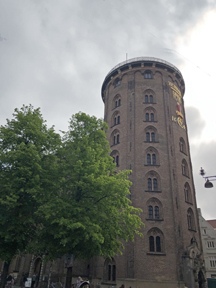 Sunday: the annual Telenor Copenhagen Marathon. Tying up a maze of streets throughout the city with its 42 km course. Getting anywhere by cab is impossible. The hotel is surrounded on two sides by water, and road closure on the other. Fortunately it’s possible to make course crossings on foot, so we’re able to make our way to Kultorvet Square in time to meet the walking tour. Our guide is Stefan, who after a few curious glances we discover is also a cook at sea in the hotel, and we had sort of seen each other over the open kitchen our first night. He’s a very nice fellow from Prague—almost everyone we’ve interacted within the service business.....bars, restaurants, guides...is a transplant from somewhere else. The 3-hour tour takes in lots of landmarks in the central district:
Sunday: the annual Telenor Copenhagen Marathon. Tying up a maze of streets throughout the city with its 42 km course. Getting anywhere by cab is impossible. The hotel is surrounded on two sides by water, and road closure on the other. Fortunately it’s possible to make course crossings on foot, so we’re able to make our way to Kultorvet Square in time to meet the walking tour. Our guide is Stefan, who after a few curious glances we discover is also a cook at sea in the hotel, and we had sort of seen each other over the open kitchen our first night. He’s a very nice fellow from Prague—almost everyone we’ve interacted within the service business.....bars, restaurants, guides...is a transplant from somewhere else. The 3-hour tour takes in lots of landmarks in the central district:
Rundetaarn, or Round Tower. built by Christian IV in the mid-17th century. The structure functioned as a church, library, and astronomical observatory—Europe’s oldest operating. We don’t have time now, but Stefan recommends the view of Copenhagen from the top.
We pass the University library to Copenhagen’s Cathedral, Vor Frue Kirke where Crown Prince Frederick married Australian Princess Mary in 2004. Stefan said that the people owning the flats across the street were paid a fortune by photojournalists for the location. In that square across Norregade is the verdigris bronze Reformation Memorial, commemorating the break from the Catholic Church in 1536.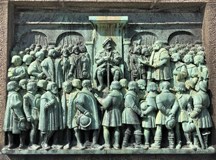
Gameltorv and Nytorv are the combined central square of the city, in the midst of which sat the original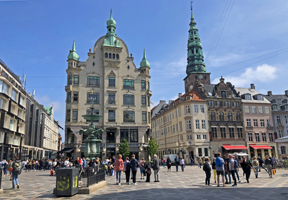 city hall, before the fire of 1795. The large courthouse dominates the west side of the square, and lovely neoclassical townhouses fill out the balance.
city hall, before the fire of 1795. The large courthouse dominates the west side of the square, and lovely neoclassical townhouses fill out the balance.
A bit further along we come to Rådhuspladsen, site of city hall on which front façade is a gilded statue of Bishop Absalon. In the square sits the Dragon Fountain, and off to the side is a statue of famed author Hans Christian Anderson. Just across the street is the entrance to the famed Tivoli Garden and amusement park. Next to that is the Ny Carlsberg Glyptotek, an enormous art museum founded in 1888 by the brewer Carl Jacobsen, of the Carlsberg Beer empire.
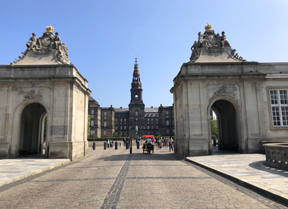 Taking the bridge across a small side channel, actually a moat around Slotsholmen Island, we enter the Christiansborg Palace area, through the Royal Stables, where a couple of impressive white stallions are placidly accepting attention and photographs. Through a passage out the palace, we get a view of the striking brick Royal Library, and pass through one of the most delightful gardens anywhere—rhododendrons ablaze with purple blooms, blue agapanthus, lip-red roses, and the pensive statue of Soren Kierkegaard gazing over all.
Taking the bridge across a small side channel, actually a moat around Slotsholmen Island, we enter the Christiansborg Palace area, through the Royal Stables, where a couple of impressive white stallions are placidly accepting attention and photographs. Through a passage out the palace, we get a view of the striking brick Royal Library, and pass through one of the most delightful gardens anywhere—rhododendrons ablaze with purple blooms, blue agapanthus, lip-red roses, and the pensive statue of Soren Kierkegaard gazing over all. 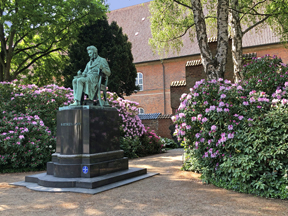
Turning north along Christians Brygge next to the Kobenhaven Havn, we’re in the thick of the race route, and come to km 40 just as the early runners pass the time clock showing at 2:31 elapsed time.
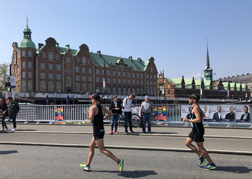 Around the bend is the stock exchange building—a lovely 17th century Dutch Renaissance style building—the first stock exchange in Denmark and one of the oldest buildings in Copenhagen. The spire showing four intertwined dragon tails is a symbol of the city. Stefan says that the building has been for sale for some time, but there are no takers, as the authorities won’t allow any modifications for use as a hotel or apartments.
Around the bend is the stock exchange building—a lovely 17th century Dutch Renaissance style building—the first stock exchange in Denmark and one of the oldest buildings in Copenhagen. The spire showing four intertwined dragon tails is a symbol of the city. Stefan says that the building has been for sale for some time, but there are no takers, as the authorities won’t allow any modifications for use as a hotel or apartments. 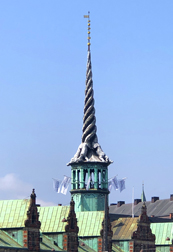
There is a view across channel to 90-meter tall spiral tower of Vors Freisers Kirke—Church of Our Saviour, baroque style church with its helical outside steps winding up around the spire. Another great view of the city to be had, if you’re willing to climb the 400 steps to the top.
Our path takes us back along Nyhaven, with more runners crossing the bridge and rounding the bend, and finally back to the hotel, just outside of which is the Waterbus stop for Nyhavn. Line 991 goes south through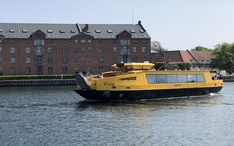 the channel, and 992 north. It’s a great deal at 24 Kroner ($4), and takes half an hour down to the end of the line, past masses after masses of new Nordic architecture in offices, apartments condominiums and public spaces.
the channel, and 992 north. It’s a great deal at 24 Kroner ($4), and takes half an hour down to the end of the line, past masses after masses of new Nordic architecture in offices, apartments condominiums and public spaces.
Danish modern architecture is amazingly diverse, with some commonalities: lightness in feeling and openness to light—understandable with the long days of low light; respect for surroundings and historic architecture....the new blends surprisingly admirably with the old; whether by code, or common agreement, nothing too high....all seem to stay at or under 8-12 stories; boldness of form...whether angular and rectilinear or sinuously curving, this city’s contemporary architecture is uniformly eye-popping.
Some standout examples:
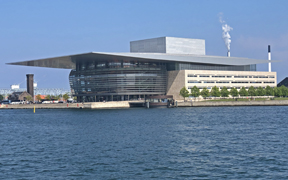 Royal Opera House, designed by Henning Larsen looms elegantly over the harbor—certainly one of the most striking opera houses in the world, along with Sydney and Oslo.
Royal Opera House, designed by Henning Larsen looms elegantly over the harbor—certainly one of the most striking opera houses in the world, along with Sydney and Oslo.
Royal Danish Playhouse—elegant low broad forms in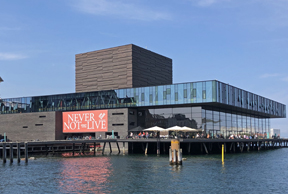 green and clear glass and deep brown brick, partially extending on stilts into the waters of the harbor.
green and clear glass and deep brown brick, partially extending on stilts into the waters of the harbor.
The Black Diamond—the Royal Library extension—one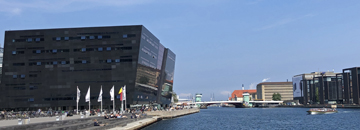 of the early pieces of dramatic new building constructed in 1999. The name refers to the jet-black marble and dark glass cladding, and the irregular angles of the facade, mimicking the facets of a diamond.
of the early pieces of dramatic new building constructed in 1999. The name refers to the jet-black marble and dark glass cladding, and the irregular angles of the facade, mimicking the facets of a diamond.
Danish Architecture Center & BLOX—an enormous assemblage of seemingly stacked modules clad in different toned glass and metals, jutting out over and looming above the channel.
Ammager Bakke, a new trash-burning energy plant hulks behind the Opera House....four prominent stacks surrounding a perforated metal-clad slant top building .... the roof of which becomes a ski slope in winter snow!
Five quite Bauhaus buildings of Maersk headquarters lined up along the channel, with landscaped open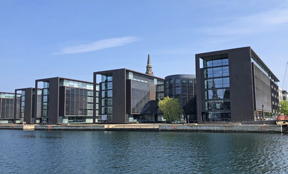 spaces between.
spaces between.
 Circle Bridge—a beautiful white bike and pedestrian bridge by Olafur Eliasson, with five suspension towers of varying heights holding circles of support cables—evoking the masts and rigging of a sailing schooner.
Circle Bridge—a beautiful white bike and pedestrian bridge by Olafur Eliasson, with five suspension towers of varying heights holding circles of support cables—evoking the masts and rigging of a sailing schooner.
The following morning, Monday, at the quayside, around the harbor and in town is so calm compared to the weekend—especially race Sunday. We stroll up Nyhavn and wander around to Stroget, the main shopping street, and window gaze along to Georg Jensen, the famous silversmiths—lovely and very expensive creations, and Royal Copenhagen Porcelain. Both overlook Storkespringvandet, the Stork Fountain at the top of bustling Højbro Plads—High Bridge Square—surrounded by appealing neoclassical buildings constructed after the great fire of 1795. At the bottom of the square is the verdigris bronze equestrian statue of Bisop Absalon, a powerful politician and 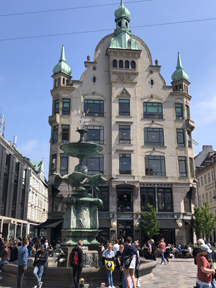 church leader in the 12th century. We stop for refreshment at a cafe on the square, to take time to admire the striking architecture all around. Plus, I’ve needed to find a Tuborg draft to compare to the ubiquitous Carlsberg, as all the locals believe it to be superior. It’s a delicious beer on a sunny midday, but without two glasses side by side, I’d be hard pressed to opine.
church leader in the 12th century. We stop for refreshment at a cafe on the square, to take time to admire the striking architecture all around. Plus, I’ve needed to find a Tuborg draft to compare to the ubiquitous Carlsberg, as all the locals believe it to be superior. It’s a delicious beer on a sunny midday, but without two glasses side by side, I’d be hard pressed to opine.
Over the canal, back through the royal stables and the library gardens, to the Danish Architecture Center in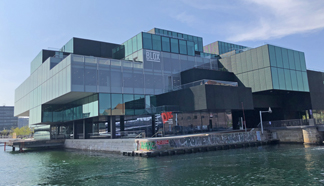 the BLOX building, another architectural masterpiece on the Havn. The huge conglomeration of glass masses is supposedly meant to mimic a Lego construction. We had expected, by the name, a comprehensive exhibit of the works of Danish architects, but it’s a combination meeting, exhibition and gathering place....with a glass gym over the water. One of the current exhibitions presents the work of noted Danish architect Dorte Mandrup, and feature several interactive exhibits highlighting her pretty amazing current projects of research facilities by the Wadden Sea in Denmark and the Ilulissat Icefjord in Greenland – both UNESCO World Heritage sites. Worth the visit, but not what was anticipated.
the BLOX building, another architectural masterpiece on the Havn. The huge conglomeration of glass masses is supposedly meant to mimic a Lego construction. We had expected, by the name, a comprehensive exhibit of the works of Danish architects, but it’s a combination meeting, exhibition and gathering place....with a glass gym over the water. One of the current exhibitions presents the work of noted Danish architect Dorte Mandrup, and feature several interactive exhibits highlighting her pretty amazing current projects of research facilities by the Wadden Sea in Denmark and the Ilulissat Icefjord in Greenland – both UNESCO World Heritage sites. Worth the visit, but not what was anticipated.
We take the yellow 992 Waterbus back to Nyhavn, and then an hour-long cruise through the back canals branching off the channel and spidering the city. There are areas of canals that are reminiscent of Amsterdam, as both Frederick II and Christian IV were interested in Dutch and Flemish Renaissance style.
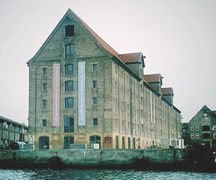 That evening we stroll over the Inderhavnsbroen footbridge to Restaurant Barr, a hot new place that occupies homey space in an old stone warehouse that was formerly the home of noma, Chef Rene Redzepi’s famous restaurant for a most interesting dinner.
That evening we stroll over the Inderhavnsbroen footbridge to Restaurant Barr, a hot new place that occupies homey space in an old stone warehouse that was formerly the home of noma, Chef Rene Redzepi’s famous restaurant for a most interesting dinner.
Our last night in Copenhagen, we meander back across the canal as the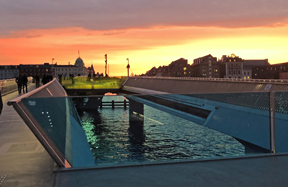 sky is only just going blue-purple with sunset left after 10 pm—we are less than a month away from the longest day of the year, in the summer-light far north. A final Negroni at the bar at 71Nyhaven, and we march off to pack for the very short trip in the morning, across Øresund to Malmo.
sky is only just going blue-purple with sunset left after 10 pm—we are less than a month away from the longest day of the year, in the summer-light far north. A final Negroni at the bar at 71Nyhaven, and we march off to pack for the very short trip in the morning, across Øresund to Malmo.
